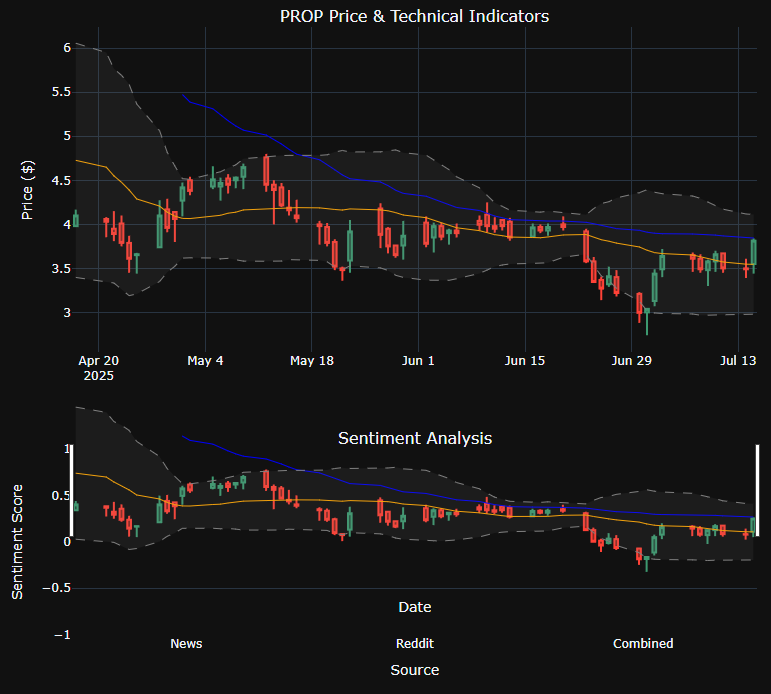Disclaimer
This analysis is for informational purposes only and does not constitute financial advice. The analysis involves significant risk and represents solely the opinion of AI-generated models. All trading and investment decisions carry substantial risk of loss. Readers are strongly advised to conduct their own research and consult with a qualified financial advisor before making any investment decisions.
1. Technical Analysis Interpretation
Prairie Operating Co. NASDAQ: PROP
PROP’s technical landscape presents a concerning picture with mixed signals that warrant careful examination. The key technical drivers reveal moderate momentum indicators, with an On-Balance Volume (OBV) reading of 0.112 suggesting some accumulation, while the volume ratio of 0.092 indicates below-average trading interest. The close-to-open ratio of 0.072 and high-low ratio of 0.072 both point to contained volatility within trading sessions, though this may reflect a lack of conviction rather than stability.
The Stochastic oscillators show relatively low readings (K: 0.046, D: 0.042), suggesting the stock is not in overbought territory but also lacking strong upward momentum. The RSI component value of 0.039 reinforces this neutral-to-weak momentum picture. Price change metrics of 0.069 indicate modest recent movement, but the overall technical configuration suggests a stock in a consolidation phase without clear directional bias.
The overall technical picture emerges as neutral with bearish undertones, characterized by low engagement and weak momentum indicators that fail to provide compelling signals in either direction.
2. Multi-Source Sentiment Analysis
News Sentiment: The company news analysis reveals a neutral stance with a score of 0.10 based on 20 articles analyzed, resulting in an overall impact of 0.05. This suggests an absence of significant catalysts or negative developments, indicating a period of relative corporate stability without major market-moving events.
Reddit Sentiment: Social media engagement presents a stark void, with a sentiment score of 0.00, zero Wall Street Bets mentions, and no posts or comments tracked. The 50% bullish ratio is meaningless given the complete absence of retail discussion. This lack of retail interest suggests either limited awareness or indifference toward PROP among individual investors.
Insider Trading: A notably bullish signal emerges from insider activity, with net purchases of 188,840 shares across 10 recent transactions. Key insiders including Richard Neil Frommer and Bryan Freeman have made substantial purchases of 5,000 shares each in June 2025, suggesting confidence from those with access to non-public information.
Synthesis: The sentiment analysis reveals a significant divergence between insider confidence and public disinterest. While institutional insiders demonstrate strong conviction through substantial purchases, the complete absence of retail engagement and neutral news flow creates an information asymmetry that could signal either an overlooked opportunity or insider knowledge not yet reflected in public markets.
3. ML Model Prediction Evaluation
Both machine learning models converge on a bearish outlook with remarkable consistency. The Random Forest model predicts a bearish direction with only a 23% probability of price increase, while maintaining a high confidence level of 77%. The Ensemble model mirrors this prediction exactly, showing a 23% probability of increase but with lower confidence at 54%.
The alignment between models strengthens the bearish signal, though the moderate confidence levels in the Ensemble model (54%) suggest some uncertainty in the prediction. The 77% confidence from the Random Forest indicates stronger conviction in the bearish direction, but investors should note that even high-confidence ML predictions carry inherent limitations and uncertainty.
The convergence at 23% probability of increase suggests that current market conditions and technical patterns favor downward price movement, though the gap between model confidence levels highlights the probabilistic nature of these predictions and the importance of risk management.
4. Market Positioning and Peer Comparison
Institutional ownership stands at 22.2%, representing a moderate level of institutional interest that falls within typical ranges but doesn’t suggest overwhelming confidence. Performance versus sector shows 0.00%, indicating PROP is tracking exactly with its peer group, suggesting sector-wide neutrality rather than company-specific outperformance or underperformance.
Notable institutional holders include Citadel Advisors LLC with 918,229 shares valued at $3.37 million, Vanguard Group Inc. holding 869,876 shares worth $3.19 million, and Woodline Partners LP with 687,432 shares valued at $2.52 million. The presence of both active management firms and passive indexers suggests a diversified institutional base.
The moderate institutional ownership level of 22.2% implies that while professional investors have taken positions, PROP hasn’t attracted overwhelming institutional conviction. This positioning could contribute to higher volatility and provide opportunities for significant price movements based on sentiment shifts or fundamental developments.
Market correlations show modest positive relationships with major indices: SPY (0.317), QQQ (0.318), and DIA (0.283), indicating some systematic risk exposure. The negative correlation with VIX (-0.332) suggests PROP tends to move inversely to market fear, which could provide some defensive characteristics during market stress.
5. Risk Assessment and Position Sizing Recommendations
The risk metrics paint an alarming picture requiring extreme caution. Value at Risk (VaR) at 95% confidence reaches 9.56% daily, indicating potential for significant single-day losses. The Sharpe ratio of -2.13 demonstrates that PROP has historically provided negative risk-adjusted returns, essentially penalizing investors for taking on its substantial risk.
Annualized volatility of 83.3% places PROP in the high-risk category, with price swings that could be emotionally and financially challenging for most investors. The Kelly Criterion position size of 0.0% provides the clearest risk signal, mathematically suggesting no allocation to PROP based on its risk-return profile.
Recommended hedging strategies include protective puts positioned 5-10% out of the money, estimated to cost 1-3% of position value while providing high effectiveness in downside protection. Given these risk metrics, conservative position sizing becomes paramount, with suggestions ranging from 0-1% for conservative investors to a maximum of 3-5% for aggressive investors with exceptional risk tolerance.
The risk assessment mandates robust risk management protocols including strict stop-loss orders, position monitoring, and potentially avoiding the position entirely for risk-averse investors.
6. Contrarian Signals or Crowded Trade Warnings
A significant divergence emerges between insider behavior and public sentiment, creating a potential contrarian opportunity. While insiders demonstrate strong conviction through substantial purchases totaling 188,840 net shares, retail investors show complete disengagement with zero social media activity or discussion.
This divergence suggests either that insiders possess material non-public information justifying their optimism, or that retail investors have overlooked potential value in PROP. The complete absence of retail interest, combined with neutral news sentiment, indicates this is not a “crowded trade” from a retail perspective.
However, the bearish ML predictions and poor risk-adjusted returns suggest caution in interpreting insider buying as a clear positive signal. The contrarian opportunity exists but requires careful consideration of whether insider confidence reflects superior information or represents a value trap that even sophisticated investors can fall into.
The lack of social media momentum and retail engagement could signal either an overlooked opportunity or justify the low institutional ownership, requiring deeper fundamental analysis to determine which interpretation proves correct.
7. Key Catalysts and Upcoming Events to Watch
While specific upcoming events aren’t detailed in the current analysis, several factors warrant close monitoring for PROP. Quarterly earnings announcements will be crucial given the current neutral sentiment and could serve as significant catalysts to shift market perception in either direction.
Given PROP appears to operate in the prop creation/supply industry, key events to monitor include contract announcements with entertainment companies, technological advancements in prop creation, and broader trends in the entertainment industry that could affect demand for professional props.
Regulatory changes affecting the entertainment industry, changes in film and television production budgets, and the continued growth of streaming services could all serve as external catalysts. Additionally, any corporate announcements regarding product launches, strategic partnerships, or management changes could significantly impact sentiment.
The divergence between insider buying and public disinterest suggests that material non-public information may exist, making upcoming public disclosures particularly important to monitor. Changes in institutional holdings and any shifts in analyst coverage could also serve as sentiment catalysts.
8. Actionable Trading Strategy with Specific Levels
Given the highly conflicting signals between bullish insider activity and bearish ML predictions, combined with poor risk metrics, a “wait-and-see” approach proves most prudent for most investors. The 0.0% Kelly Criterion position size and negative Sharpe ratio argue strongly against establishing positions.
Short-Term Strategy (1-7 days): Avoid new positions given the 83.3% annualized volatility and 9.56% daily VaR. If forced to trade, extremely tight stop-losses at 3-5% would be essential, though this conflicts with the high volatility environment.
Medium-Term Strategy (1-3 months): For aggressive investors willing to bet on insider information proving correct, consider micro-positions of 1-2% maximum allocation with protective puts as outlined in the hedging strategy. Entry should wait for clearer technical signals or fundamental catalysts.
The highly conflicting signals make specific entry/exit levels difficult to establish with confidence. The risk metrics suggest that any position sizing should prioritize capital preservation over profit maximization, making this unsuitable for most investment portfolios.
For those determined to establish exposure, a phased approach with multiple small positions and predetermined exit criteria based on either fundamental developments or technical breakouts would prove more appropriate than traditional level-based strategies.
Overall Summary
PROP presents a cautious bearish to neutral outlook for both short-term and medium-term horizons. The convergence of multiple bearish ML predictions, poor risk-adjusted historical performance, and extremely high volatility overshadow the positive signal from insider buying activity.
Key uncertainties center on the disconnect between insider confidence and market sentiment, the absence of retail interest despite institutional positions, and the neutral fundamental backdrop. Critical factors for monitoring include any material news that could explain insider buying patterns, earnings performance, and broader industry developments.
The analysis strongly emphasizes the need for a highly cautious approach with conservative position sizing, if any allocation is considered at all. The mathematical recommendation of 0% position size from the Kelly Criterion, combined with the negative Sharpe ratio, suggests most investors should avoid PROP entirely until risk metrics improve or fundamental catalysts emerge.
For sophisticated investors in the business of evaluating high-risk opportunities, PROP represents a case study in information asymmetry where insider knowledge conflicts with quantitative risk metrics. Success requires exceptional due diligence, advanced presentation skills in risk assessment, and the confidence to act on incomplete information while maintaining rigorous performance standards through disciplined risk management. Such investment opportunities demand executive-level decision-making capabilities and comprehensive training in advanced portfolio management techniques, as the potential for both significant losses and gains requires coaching in emotional discipline and strategic thinking that goes beyond traditional investment approaches.

